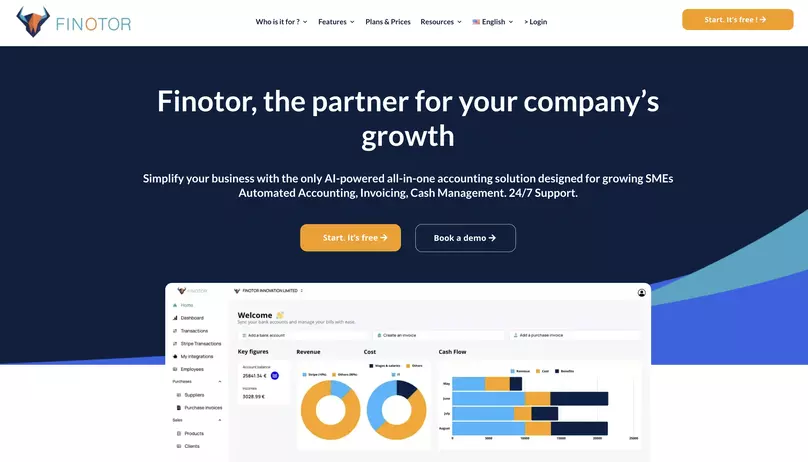Contents
- 1 Introduction to budget monitoring
- 2 The importance of effective budget monitoring
- 3 The consequences of poor budget monitoring
- 4 The basic rules for effective budget monitoring
- 5 Define clear financial objectives
- 6 Allocate resources appropriately
- 7 Regularly monitor income and expenditure
- 8 Analysing variances and adjusting budgets
- 9 Tools and methods for optimal budget monitoring
- 10 Financial management software
- 11 Dashboards and financial reports
- 12 Forecasting expenditure and revenue
- 13 Automating budget monitoring
Introduction to budget monitoring
Budget monitoring is a crucial aspect of financial management for both individuals and businesses. It involves regularly monitoring and evaluating income and expenditure to ensure that financial targets are being met. Effective budget monitoring allows you to make informed decisions, optimise spending, save wisely and avoid cash flow problems.
The importance of effective budget monitoring
Effective budget monitoring is extremely important for both individuals and businesses. Here’s why:
– Allows you to set clear financial objectives: By regularly monitoring budgets, it becomes easier to define realistic and measurable financial objectives. This makes it possible to determine the proportion of income to be devoted to savings, investments or expenditure.
– Helping to optimise expenditure: By monitoring and analysing expenditure, it is possible to identify areas where savings can be made. This may involve looking for more economical solutions, reducing unnecessary expenditure or renegotiating contracts.
– Preventing excessive debt: Regular monitoring of budgets enables spending to be kept under better control, thereby avoiding excessive debt. It also helps you to know your real ability to repay existing debts and to better manage the loans you take out.
– Encourages savings: With a clear picture of your income and expenditure, it’s easier to adjust your budget to make regular savings. By monitoring budgets, you can ensure that your savings target is met, by setting rules and concrete ways of achieving it.
– Makes it easier to make decisions: With accurate information about the state of your finances, it’s easier to make informed decisions. Whether you want to invest in an opportunity, cut back on certain expenses or plan savings for a future project, budget monitoring provides the data you need to make informed financial decisions.
The consequences of poor budget monitoring
Poor budget monitoring can have negative consequences for both individuals and businesses. Here are some of the negative consequences that can result from poor budget management:
– Financial difficulties: Inadequate or non-existent budget monitoring can make it difficult to manage personal or business finances. This can lead to cash flow problems, excessive debt or a lack of visibility over future expenditure.
– Loss of control over spending: Without regular monitoring of budgets, it becomes difficult to control spending and identify areas where savings can be made. This can lead to overspending, budget overruns and an inability to meet financial targets.
– Unwise decision-making: Without accurate data on the state of finances, financial decisions can be taken imprudently. This can lead to risky investments, impulsive buying decisions or uncontrolled spending, compromising overall financial health.
– Inability to achieve financial goals: Poor budgeting can make it difficult to achieve financial goals. Whether it’s saving for a project, investing in a business expansion or simply maintaining a comfortable standard of living, inadequate budget monitoring can lead to delays or an inability to achieve these goals.
In short, effective budget monitoring is essential for achieving financial objectives, optimising expenditure, avoiding cash flow problems and making informed decisions. It allows you to stay in control of your finances, plan for savings and control expenditure, thereby contributing to sound and balanced financial management.
The basic rules for effective budget monitoring
Managing a budget is essential for good financial health. Whether at a personal or professional level, it is crucial to keep a close eye on expenditure and income. Not only does this help to avoid debt problems, it also enables you to plan your financial objectives effectively. Here are the basic rules for effective budget monitoring:
Define clear financial objectives
To begin with, it’s important to define clear financial objectives. Whether it’s saving for a future project, paying off debts or increasing your income, having clear objectives will help you focus your efforts. It also keeps you motivated and helps you measure your progress. By setting achievable and measurable goals, it’s easier to keep track of your financial situation and take the necessary steps to achieve them.
Allocate resources appropriately
Once the objectives have been defined, it is essential to allocate resources appropriately. This involves drawing up a budget based on your income and expenditure. It’s a good idea to divide your budget into different categories, such as living expenses, savings, leisure activities, etc. This approach gives you a clearer picture of your spending and gives you greater control over your finances. It’s also a good idea to leave some room for manoeuvre to deal with the unexpected.
Regularly monitor income and expenditure
Regular monitoring of income and expenditure is a key stage in budget tracking. It is advisable to keep an expenditure diary in which you record all the expenses you incur. This enables you to visualise your spending habits and identify areas where adjustments are needed. It’s also important to keep a record of all the money you bring in, so that you have an overall view of your income. Having a clear picture of your expenditure and income not only makes it easier to manage your budget, but also to spot any financial leaks.
Analysing variances and adjusting budgets
Finally, it is essential to regularly analyse the discrepancies between actual expenditure and the planned budget. By identifying variances, it is possible to spot excessive or unforeseen expenditure and take the necessary steps to rectify it. This may involve reducing certain expenses, finding more economical solutions or optimising sources of income. By adjusting your budget to take account of variances, you can maintain effective budget monitoring and stay in control of your financial situation.
In conclusion, budget monitoring is a proactive method of managing your finances effectively. By following basic rules such as setting clear financial objectives, allocating resources appropriately, regularly monitoring expenditure and income, analysing variances and making budget adjustments, you can take control of your finances and achieve your financial objectives. So don’t wait any longer, set up effective budget monitoring now and take control of your financial future!
Tools and methods for optimal budget monitoring
Budget management is essential if you want to achieve your financial goals and save effectively. To ensure optimal budget monitoring, there are a multitude of tools and methods that simplify the management of expenditure and income. In this section, we’ll introduce you to a few solutions that will help you achieve your financial goals more easily.
Financial management software
For effective budget management, the use of financial management software is often recommended. These tools allow you to centralise all your financial information, create a personalised budget and track your spending in real time. Some software even offers advanced features such as automatic categorisation of expenses, generation of detailed financial reports and the ability to synchronise your bank accounts. Among the most popular software solutions are Mint, YNAB (You Need A Budget) and Quicken.
Dashboards and financial reports
Another essential tool for optimum budget monitoring is the financial dashboard. This is a visual tool that brings together all the key information about your financial situation. At a glance, you can see your bank balance, the amount of your expenditure and income, and how your savings are progressing. Some dashboards also offer the option of customising the indicators according to your specific financial objectives. For advanced users, it is also possible to generate detailed financial reports, giving you a precise view of your budgetary position. Tools such as Zoho Analytics, Google Data Studio and Power BI make it easy to create customised dashboards and reports.
Forecasting expenditure and revenue
To avoid surprises and keep control of your budget, forecasting expenditure and income is an effective way of anticipating financial fluctuations. Several methods can be used to estimate your future expenditure, such as analysing your past expenditure, taking into account recurring expenditure or creating expenditure categories. You can also use specialist tools such as iBudget, PocketGuard or Spendee to help you with this task. This will help you plan your spending more effectively and ensure that you achieve your financial goals.
Automating budget monitoring
To make budget monitoring even simpler, you can automate certain tasks. For example, you can set up notifications to alert you when you exceed a certain spending threshold, or make automatic transfers to your savings account every time you receive an income. Automation allows you to save time and focus on more important activities. Applications such as Tiller Money, Honeydue and PocketSmith allow you to automate certain parts of your budget monitoring.
By using these tools and methods, you’ll be able to manage your budget more effectively, maximise your savings and achieve your financial goals more quickly. With the right solutions at your disposal, you can take control of your finances with complete peace of mind, while avoiding problems of debt and over-indebtedness. So don’t wait any longer, explore these tools and start saving now, with the utmost care!
Best practice for effective budget monitoring
To ensure optimum management of your budget, it’s essential to put in place good practices that will enable you to track your spending effectively and achieve your financial goals. Here are a few tips to help you do just that:
Involve stakeholders
Stakeholder involvement is essential to the success of your budget monitoring. This means communicating regularly with different stakeholders, such as department heads and members of the finance team. By keeping them informed about the status of expenditure and financial targets, you encourage their commitment and accountability in managing the company’s budget.
– Organise regular meetings to discuss budget monitoring and allow stakeholders to express their concerns and ideas.
– Involve department managers in setting budgets, encouraging them to propose realistic targets and making them accountable for achieving them.
– Set up key performance indicators (KPIs) for each department, in order to monitor progress and the effectiveness of actions taken.
Communicating results effectively
Effective communication of budget results is necessary to keep stakeholders informed and motivated to achieve the objectives set. Here are some ways of communicating results effectively:
– Establish regular reports on the status of expenditure and variances in relation to the planned budget.
– Use graphs and tables to make the data clear and easy to understand.
– Organise budget review meetings to discuss results and establish adjustment strategies if necessary.
Identify and correct budget variances
It is important to identify budgetary slippages early on and take corrective action to rectify them. Here are some tips on how to do this:
– Regularly monitor expenditure and compare it with allocated budgets.
– Identify expenditure items that exceed the budget and look for solutions to optimise costs.
– Set up rules for validating expenditure to avoid unauthorised spending.
Adapt to changes and new information
Budget monitoring must be flexible and able to adapt to changes and new information that may arise. Here are some ways of anticipating and managing these changes:
– Carry out regular budget reviews to take account of new objectives and/or new information.
– Automate certain budget monitoring tasks using specialised tools and software.
– Take economic precautions by building a safety margin into your budget to cope with possible economic fluctuations.
By following these best practices, you will be able to guarantee the effectiveness of your budget monitoring and optimise the management of your financial resources. Don’t forget to remain vigilant and flexible in order to adapt to any changes that may occur.









